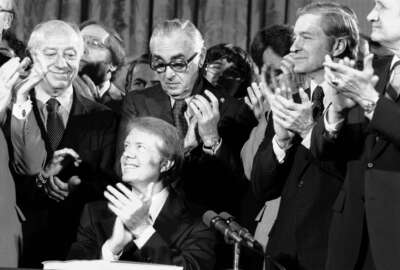You keep a close eye on all things locality pay
A Federal Drive interview didn't quite get locality pay right. Sharp-eyed readers wrote in to let me know about it! Here's some of the straight dope.
One thing I’ve learned about writing or broadcasting to highly specialized audiences over a 47-year career: Readers and listeners often know as much or more about a topic as I do. For example, federal employees are highly tuned to the nuanced vibrations of locality pay.
Locality pay, although an imperfect system, aims to close the potential gaps between federal and private sector salaries for a given line of work.
Recently I aired, then posted the transcript of, an interview with an attorney who didn’t quite state the particulars of locality pay correctly. The context of the interview is a bill proposed by Sen. Bill Cassidy (R-La.). It would yank regular raises and locality pay adjustments for federal employees who telework one day a week or more. It stands virtually no chance of passage, and probably wouldn’t stand up in court. Yet it rankles.
Several readers, reading the transcript of the interview, wrote to point out a few things. No, locality pay is not a cost-of-living calculation but rather an adjustment derived from pay for comparable jobs in a given area. That data in turn comes from one of the survey series of the Bureau of Labor Statistics. The Office of Personnel Management, as E. pointed out, states: “In the locality pay program, Federal pay is compared to non-Federal pay for the same levels of work.”
The interviewee stated that federal employees receive locality pay according to the location of the office to which they report. This is basically true, as stated by OPM: “Certain location-based pay entitlements (such as locality payments, special rate supplements, and nonforeign area cost-of-living allowances) are based on the location of the employee’s official worksite associated with the employee’s position of record.”
That is, if you work at a federal office in New York City or Enid, Oklahoma, you’ll receive the applicable locality pay for the respective location.
Telework and remote work complicate, almost fractalize, the picture. OPM says, a bit vaguely, “An agency must determine the designate the official worksite for an employee covered by a telework agreement on a case-by-case basis…” (My two cents: Who in “an agency” makes the decision?)
Those three-day-a-week teleworkers, that is, those who have to report “at least twice each biweekly pay period” get the locality pay of the office location. One reader falls into exactly this category. He works for the Treasury Department at its main headquarters. As such, he said his locality pay is that of the District of Columbia.
Fully remote employees do get the locality of where they live. Case in point: An Army financial employee works for an office in Arlington, Virginia. He wrote to say that as a “full remote telework worker … I receive the locality pay for Philadelphia, the area in which my home is located.” My Treasury writer confirmed that’s the policy there, too. If you telework but don’t have to go to the office in person regularly, then the location of your home, telework center “or other alternative worksite” becomes your locality pay location. It’s possible for the two locations, home and agency offices, to be in the same locality pay zone.
Another variant concerns those who move around a lot — those “whose work location varies on a recurring basis,” in OPM’s words. Such people can get the locality pay of the official worksite, yet they don’t need to show up there regularly.
If you want even more details for other situations, you’ll have to read OPM’s Fact Sheet on where the heck your officials worksite sits. OPM does a decent job of explaining it all.
So my thanks to those who wrote. It made me recall an incident from many years ago. I wrote something about the market for industrial O-rings that O-ring manufacturers disagreed with. I had urged purchasing agents to press for discounts on O-rings in a weak market. Let me tell you, I heard about it in no uncertain terms. It did take longer than it would have today; this was the pre-email days of dial phones and manila interoffice memo packets.
Today the feedback comes much faster.
Copyright © 2025 Federal News Network. All rights reserved. This website is not intended for users located within the European Economic Area.
Tom Temin is host of the Federal Drive and has been providing insight on federal technology and management issues for more than 30 years.
Follow @tteminWFED







